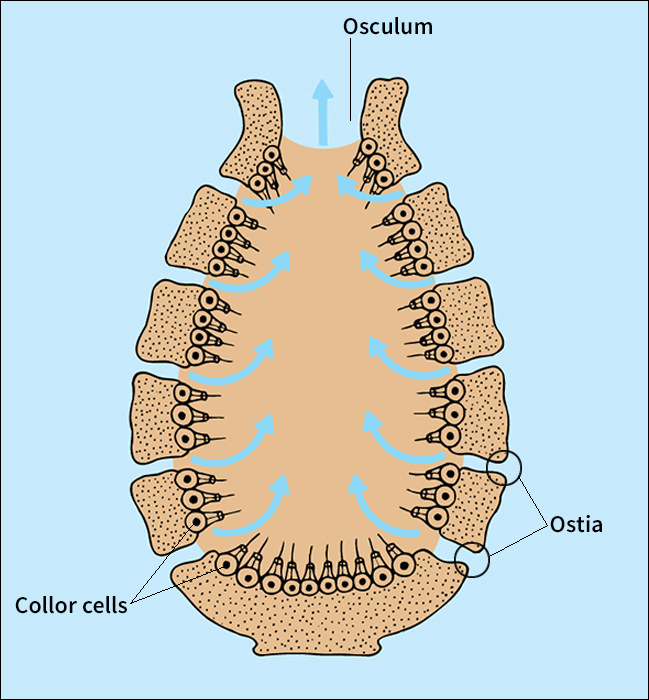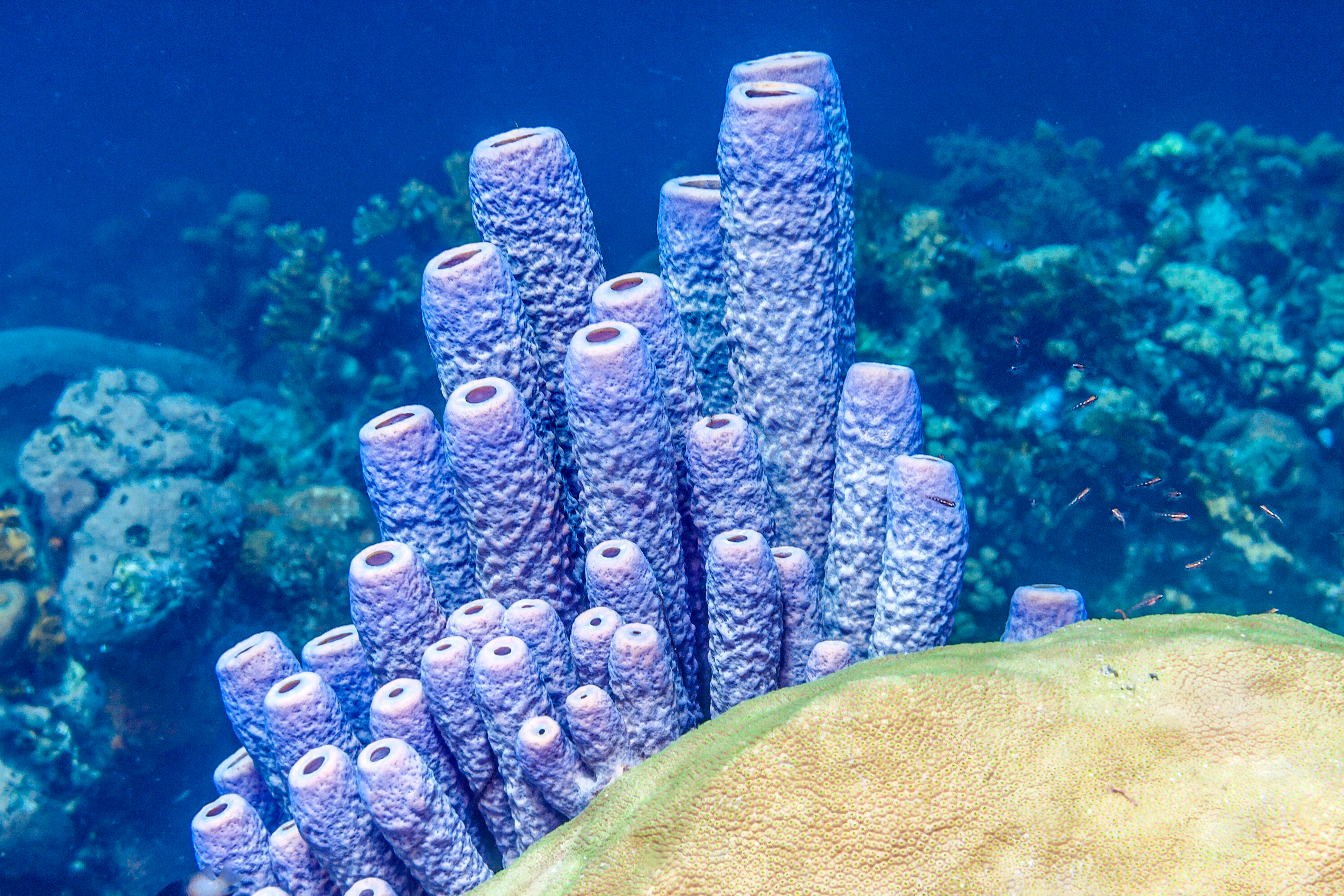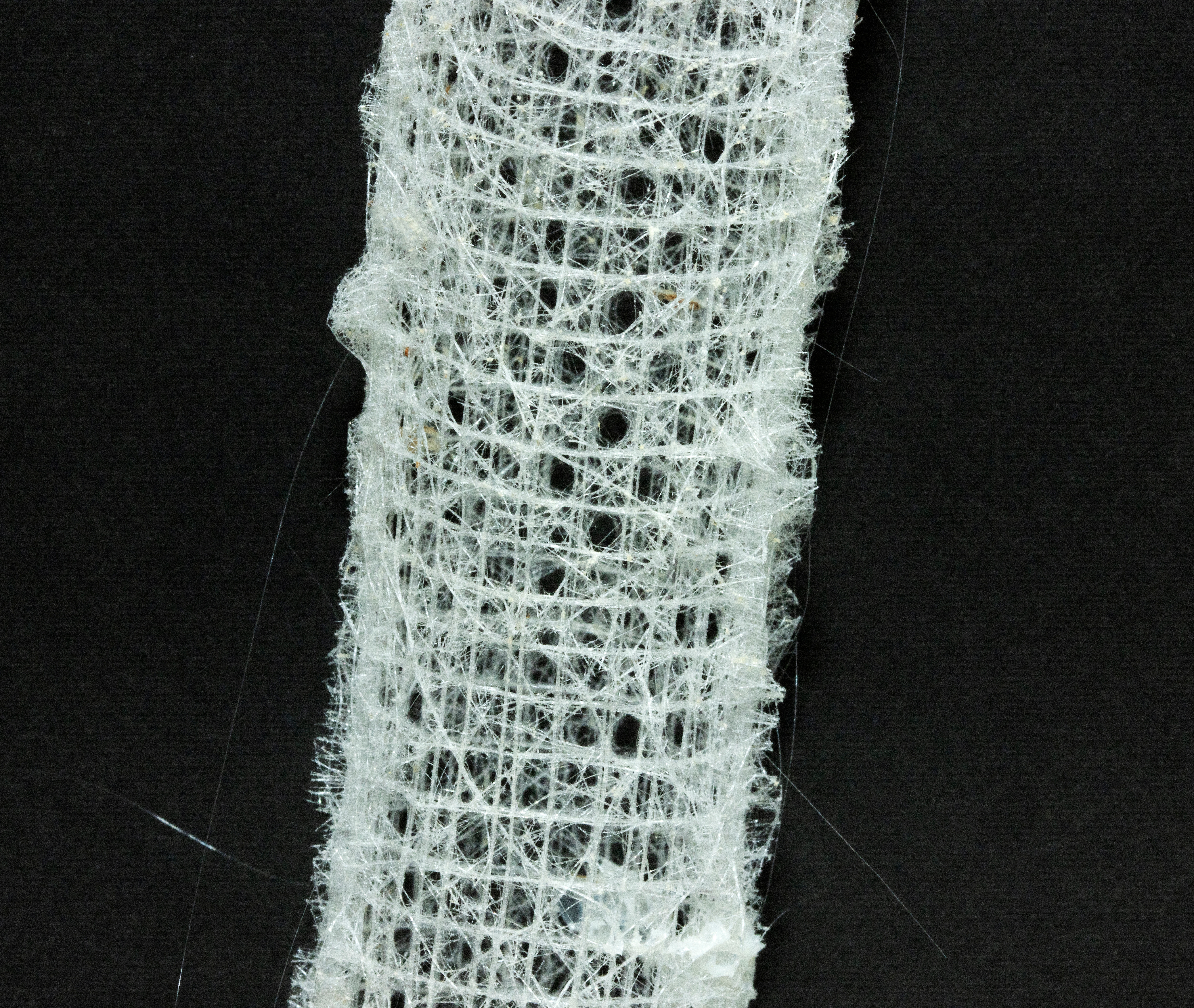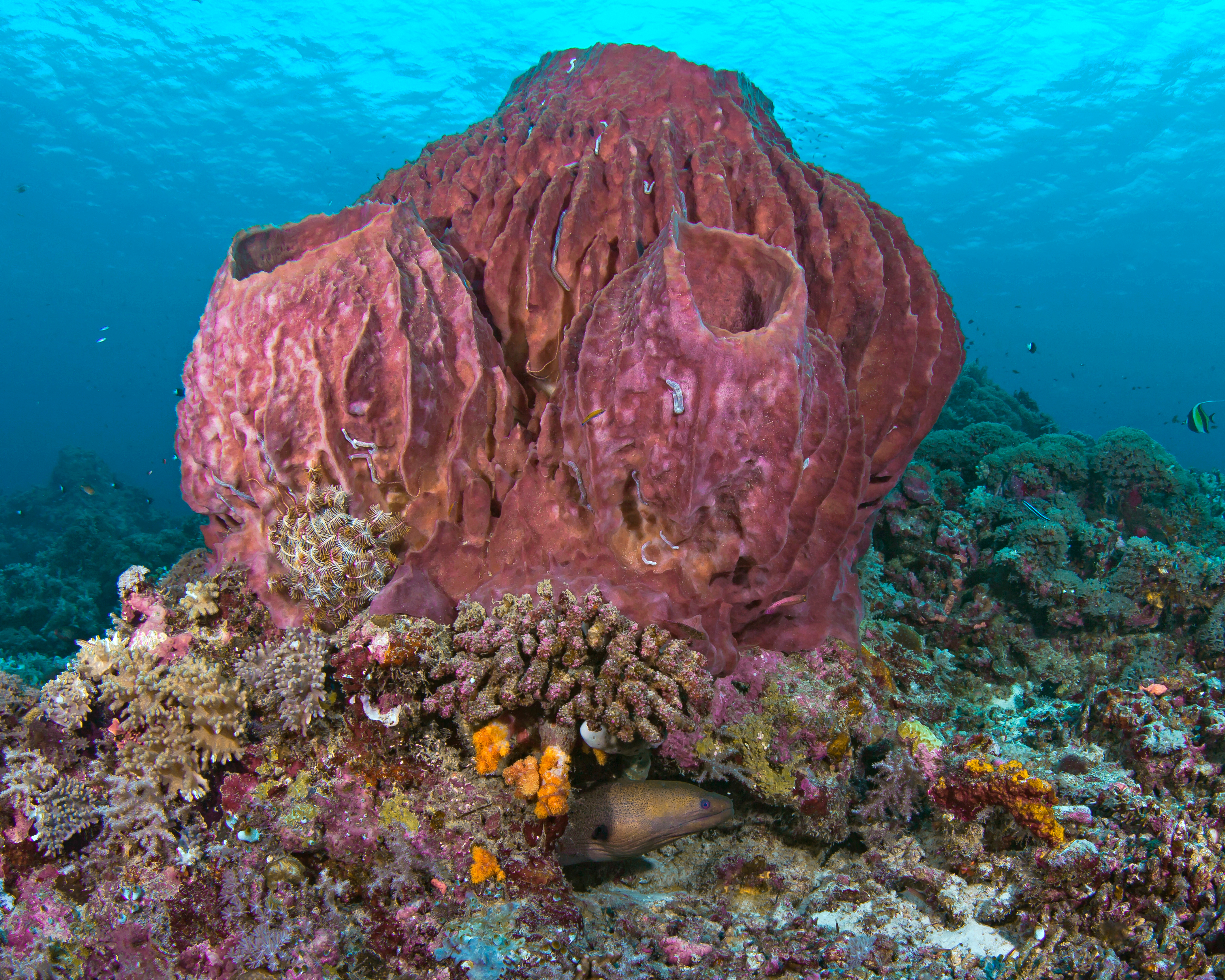Sponge is an animal that lives at the bottom of oceans and other bodies of water. Sponges do not have heads, arms, or internal organs. They live attached to rocks, plants, and other objects beneath the water’s surface. Adult sponges do not move about from one place to another, and many sponges look like plants. For these reasons, people once regarded sponges as plants. But today, scientists classify sponges as animals. Like most animals, sponges eat their food. They cannot manufacture their own food, as do plants. 
There are about 5,000 species of sponges. Most of them live in oceans, but a few species are found in lakes, rivers, and other bodies of fresh water. Sponges can live in both shallow and deep water. Most marine (ocean-dwelling) sponges inhabit warm or tropical seas.
Sponges are among the oldest kinds of animals. Fossils have been found of marine sponges that lived more than 500 million years ago. For centuries, people have used sponges for cleaning and bathing. The skeletons of certain sponges make good cleaning tools because they are soft and absorb large amounts of water. Commercial fishing crews still harvest bath sponges in the Gulf Stream and the Mediterranean Sea. However, most cleaning sponges are artificially produced. 
Recently, scientists have discovered chemical compounds in sponges that may be used in medicines to fight cancer and other diseases. Because sponges harbor large populations of bacteria in their body tissues, the bacteria may produce many of these compounds. Such important discoveries have led to an increased amount of research involving sponges.
The bodies of sponges
Sponges vary widely in shape, color, and size. Some sponges are round while others are shaped like vases. Many simply follow the shape of the object on which they grow, forming a living crust. Marine sponges range in color from bright yellow, orange, or purple, to gray or brown. Sponges of the same species may be of many different colors. Most freshwater sponges are green, purple, or gray. The smallest sponges measure less than 1 inch (2.5 centimeters) in diameter. The largest grow to more than 4 feet (1.2 meters) in diameter.


Body openings.
A sponge has two types of openings on its body surface: (1) small pores called ostia, and (2) a large osculum. The sponge’s ostia allow water to enter its body, and the osculum allows water to leave the body. Among more advanced sponges, a network of canals transports water entering through the ostia to all parts of the sponge. The water brings tiny plants and animals into the sponge. These tiny organisms are the sponge’s food. Waste products—along with water—leave the sponge through the osculum.
Special cells.
The canals that pass into the sponge’s body lead into many small chambers. These small chambers in the sponge are lined with cells called choanocytes, also known as collar cells. Each of these cells has a delicate tissue, or collar, that acts like a net to trap food particles. Each collar cell also bears a long threadlike structure called a flagellum. The sponge’s flagella whip around, and this action creates the water currents that flow through the body of the sponge.
In addition to collar cells, the sponge’s body also contains other types of cells. Some of these cells form tissue that covers the sponge’s body and the walls of the canals inside the body. Other types of cells travel freely within the sponge. These cells have many different functions. For example, some heal injuries to the body and others play a major role in reproduction. Still others produce material for the sponge’s skeleton.
Skeleton.
Sponges have several types of skeletons. Most sponges have a mineral skeleton made up of tiny, needlelike spicules. The spicules may be of either calcium carbonate (limestone) or silica, a glasslike mineral. In bath sponges, the skeleton consists only of fibers of a tan-colored protein called spongin. The skeleton of spongin fibers is what remains after a bath sponge dies and its cells are removed. Many sponges have a skeleton of both mineral spicules and spongin fibers. In other sponges, the skeleton consists of silica spicules, spongin fibers, and a massive base of limestone crystals. 
The sponge’s skeleton forms a framework that supports and protects the body. Spicules may be organized into bundles that form strong, geometric networks. In many sponges, numerous spicules grow around the osculum. These spicules protect the sponge from animals that try to eat it or enter its body.
How sponges reproduce
Sponges reproduce both sexually and asexually. In sexual reproduction, a new sponge develops from the joining of two sex cells. In asexual reproduction, a new sponge is formed by methods that do not involve sex cells. Most sponges also have the ability to replace lost or injured body parts by growing new ones. This process is called regeneration.
Sexual reproduction
in sponges begins when an egg (female sex cell) starts to grow inside the parent sponge’s body. At first, the egg absorbs food from surrounding body fluids. Later, it engulfs cells called nurse cells, which provide food reserves. When fully grown, the egg is fertilized by a sperm (male sex cell). Some sponges produce both eggs and sperm. In these species, the egg may be fertilized by a sperm from the same animal.
Other species produce either eggs or sperm only. In these species, another sponge releases sperm into the surrounding water. A sperm enters the parent sponge’s body by way of the ostia and canal network and fertilizes the egg.
After the egg is fertilized, it gradually develops into a larva (immature animal form). The larva is covered with cells that have flagella. The flagella beat rapidly, enabling the larva to swim outward through the parent’s canal system, aided by water currents. The larva leaves the sponge through the osculum and swims around from a few hours to a few days. It then attaches itself to some suitable surface at the bottom of the body of water and develops into an adult sponge.
Asexual reproduction
in sponges may occur in a variety of ways. In every case, however, it involves cells called archaeocytes. These cells have no specialized functions. Instead, they have the capacity to develop into any type of cell in the sponge’s body. During asexual reproduction, a group of archaeocytes grow into every type of cell needed to form a new sponge.
Sponges may reproduce asexually by budding. In this process, buds or branches filled with archaeocytes grow on the parent sponge. These growths may break away from or fall off the parent sponge or remain attached to it. The growths eventually develop into new sponges.
Some marine sponges and most freshwater sponges also may reproduce asexually by forming gemmules. Gemmules are budlike structures that consist of a group of archaeocytes within a tough shell of spongin. Many gemmules are reinforced by spicules. Gemmules typically form in response to either cold or hot weather. Protected within the gemmule shell, the archaeocytes can survive periods of drought or freezing temperatures, though the parent sponge may die. Gemmules “hatch” when more favorable weather returns. The archaeocytes then spread out on a solid surface and develop into a new sponge.
Regeneration.
The developmental abilities of archaeocytes give sponges remarkable powers of regeneration. Even if large parts of a sponge’s body are lost or damaged, they may be replaced or repaired. In laboratory experiments, scientists have pressed sponges through extremely fine cloth so that the bodies of the sponges break up into separate cells or clumps of cells. When these cells are replaced in water, they first migrate together to form rounded cell clusters. Then the cell clusters reorganize to form complete sponges again.
Kinds of sponges
Sponges make up a phylum (major group) of animals called Porifera, which comes from a Latin word meaning pore-bearer. Zoologists divide sponges into three classes, based chiefly on common skeletal features. 
Sponges with a limestone skeleton belong to the class Calcarea. Most species in this class inhabit shallow parts of oceans, but some have been found at depths of up to 13,000 feet (4,000 meters). The tiny sponge called Sycon belongs to this group.
A second class, called Hexactinellida, consists of marine sponges with a silica skeleton. These species are commonly called glass sponges. Their spicules form beautiful geometric patterns. Glass sponges live as deep as 23,000 feet (7,000 meters) beneath the ocean’s surface. The Venus’s-flower-basket is a typical kind of glass sponge.
All freshwater sponges and most of the best-known marine sponges are in the class Demospongiae. Most of these animals have a skeleton of silica or spongin or of both substances. One kind of sponge in this class, the boring sponge, bores into coral, seashells, and other hard structures. This activity helps shape such marine environments as coral reefs and seacoasts. Other marine species in this group of sponges include the red-beard sponge, the sheepswool sponge, and bath sponges.
Some ocean sponges have a skeleton of silica and spongin with a thick base of limestone. Scientists include these sponges, sometimes called coralline sponges, in either the class Calcarea or Demospongiae. Many coralline sponges live in underwater caves. They are closely related to marine sponges that lived hundreds of millions of years ago.
